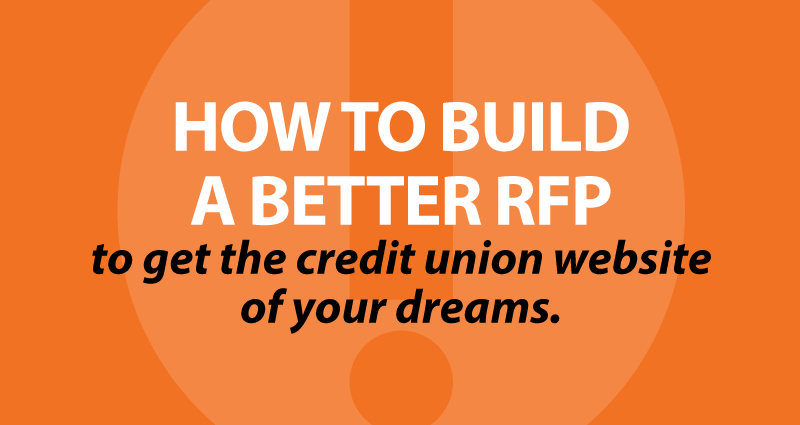
A better way to build a credit union website RFP
We’ve built a lot of credit union websites and we’ve seen and responded to a lot of website RFPs (Requests for Proposals). And let’s be honest here: most RFPs and RFP processes… aren’t that great.
Most CU website RFPs tend to be based on generic “fill in the blank” templates that focus on technology, laundry lists of features, and innumerable small details, while missing the strategic, brand, and marketing “big picture”.
Properly managing the RFP process is also pretty important. Who’s going to get an RFP? How are you going to evaluate the responses? What if you don’t quite understand a requirement or response? What are the indicators of success? Are you paying attention to what’s really important?
Here’s how to build a better RFP to help make sure you get the credit union website of your dreams.
Find just a few potential partners
There are lots of firms all over the world that build great websites. And there are quite a few that have built credit union websites.
But there are only a handful of us that specialize in building world-class credit union websites. Credit union websites are weird, so it’s worth seeking out the specialists before you dive deep into requirements.
Figure out who the best few CU website builders are, and get to know them. Rummage through their websites, and take a look at some of their work. Get in touch, ask some questions and get some advice. Really. We don’t bite.
Can they explain things to you clearly? Are you talking to salespeople, account managers, or actual developers? Do they seem CU, brand, and marketing savvy? What’s the “next big thing” they can’t wait to bring to their next website? Do they seem like people you might like to work with? Contact a few of their other clients and get nosy.
You should end up with no more than two or three options and probably a strong preference. All should be firms you’d be happy to work with, with plenty of relevant experience.
Decide how to decide
With only a few contenders, most of your decision is made. By now you should be acquainted, and so your goal is to provide the remaining info your vendors will need to ensure you’re all on the same page and help you make the right decision.
Figure out what’s most important to you. Look for decision factors beyond the basics. Download our handy Website Checklist to help sort out your priorities.
You want to confirm the basics (security, reliability, mobile, accessibility, features, expandability, etc.), but focus your decision-making on finding the best fit for your brand, culture, and growth strategy.
Build your RFP
The RFP should be pretty brief; maybe two pages max. Let your experts be experts. Lean on their expertise; tell them what your big-picture priorities are and let them make recommendations.
How will they meet your needs and wants now and in the future, and do you understand the answers?
To help with this stage, we’ve put together a handy-dandy Better Website RFP, that follows the same steps as the Checklist to make it easier to track responses. This RFP is meant to be customized, so feel free to copy, paste, annotate, and remix bits and pieces to make it completely your own and fit your unique brand and your growth strategy.
- CU Numbers Need Marketing Love, Too - April 2, 2024
- Will it blend? The only CU fintech question that matters. - February 13, 2024
- Solving the CU marketing “now what?” problem - January 16, 2024
